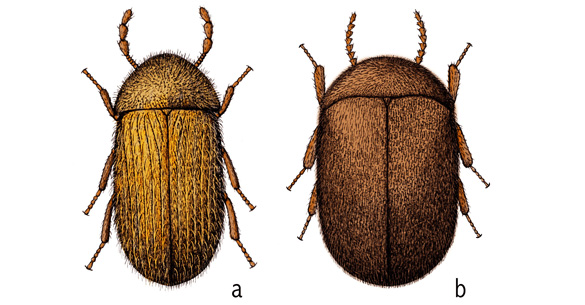
The drugstore (a) and cigarette beetles are two of the most common stored product-infesting beetles.
The cigarette and drugstore beetles (Coleoptera: Anobiidae) are two of the most common pests of stored products in homes. Both species are found throughout the world. The cigarette beetle, Lasioderma serricorne (Fabricius)(Fig. B), is common throughout tropical and subtropical regions, and is commonly found in heated buildings in temperate areas. The drugstore beetle, Stegobium paniceum (Linnaeus) (Fig. A), is characteristically more temperate than tropical.
Identification
Cigarette and drugstore beetles resemble other anobiid beetles, including the anobiid powderpost beetle. Adult beetles are rounded in profile, oval shaped, light-brown color, 1/16-1/8 inch-long. A hood-like shield (prothorax) encloses and conceals the head when viewed from above. The femora of each hind leg retracts into a groove in hind coxa.
Cigarette and drugstore beetles can be distinguished by grooving on the wing covers and by their antennal shape. The drugstore beetle’s wing covers possess distinct striae, or grooves, and its antennae are clubbed with three elongated and broadened segments at the tips. The wing covers of cigarette beetles are very smooth, without distinct grooves; and the antennal segments are sawlike, or serrate.
Mature larvae are up to 3/16 inch-long, white, c-shaped and almost cylindrical, with all body segments similar in size. Each leg has 4-segments. Hairs, or setae, covering the bodies of larval cigarette beetles are longer and more apparent than those on drugstore beetle larvae.
Damage
These two species are among the most common stored product pests in Texas homes. They feed on all kinds of plant material including tobacco, seeds, grain, nuts, beans, spices, cottonseed meal, dried fruits and vegetables, flour, spices, and dried herbarium specimens. Animal products such as dead insects, dried fish and fish meal, and leather may also be attacked. On grains, these insects are classified as external feeders. Adults and larvae feed primarily on the outside of the grain, though they may also chew through the outer coat and devour the insides. Both species are among the most common stored product pests both in homes and in commercial food processing and distribution facilities, worldwide. Neither of these beetles bite.
Biology
Females lay up to 100 eggs over a 6-20 day period in crevices, folds, or depressions in their food. The time needed to develop depends on the food source and other environmental conditions, but ranges from 26 to over 100 days (commonly, 30-50 days). Optimal conditions for development are 70-80% RH, and temperatures between 68° and 86°F. Development generally ceases below 59°F and above 94°F.
The number of larval instars ranges from four to six. Newly hatched larvae are very active and can enter food packaging through very small holes, including minute seams around lids of spice containers. Pupation occurs in loosely constructed pupal cells within the food source. Adults of both species can fly.
Control
The keys to managing an infestation of cigarette or drugstore beetles include good sanitation, early detection and locating and destroying infested materials. Insecticides alone are rarely effective. Check all stored food packages and potential food items listed above, and discard any infested food products that you find. Other places to look:
- Pet foods are common sources of infestation. In addition to checking product bags, look in difficult to clean areas, where pet food or bird seed may have spilled.
- Old school art projects involving beans, nuts or seeds
- Forgotten bags of pecans, other nuts
- Spices, potpourri, other dried plant material
- Cigarettes, pipe tobacco
- If your home has been previously infested with a mouse or rat, old rodent nests can be infested. Rodents often hoard food, such as seed or dog food, in their nests. After the rodents leave or are controlled, the food in abandoned nests can be the source of a difficult-to-locate infestation.
- Rodent bait. Bait packets thrown in corners of attic or crawl space can be a source years after placement.
Heat treatment is routinely employed against these and other insect pests in museums when receiving new artifacts, like herbarium specimens. Heating artifacts to 125°F for two to four hours, or freezing infested materials at 0°F for six days, is generally sufficient to kill all life stages of anobiid beetles. Small quantities of pet food may be dis-infested by placing in a cold freezer for two weeks. Pet food treated in this manner can then be safely fed to pets.
Dried flower arrangements can be protected to some extent by treating storage containers with a desiccant dust like silica aerogel or diatomaceous earth. Dust the box or container lightly before placing the flowers inside.
Pheromone traps have been developed for both species. These traps use a special sex-scent to attract male beetles. Effectiveness of these traps can be enhanced by placing them near windows or other light sources. In commercial operations pheromone traps can be used to determine where infestations are located and when aerosol applications of pesticides may be needed. Aerosol applications of insecticides like pyrethrins or resmethrin can suppress adult cigarette beetle populations temporarily, but do not eliminate larval infestations.
For more information
For more information about stored product pests, see Extension leaflet E-486, Pantry and Fabric Pests in the Home. Pheromone traps for these beetles can be purchased online from a variety of vendors.
Images courtesy U.S. Department of Agriculture.
Author
Michael Merchant, Ph.D., Professor and Extension Urban Entomologist, Texas AgriLife Extension Service
